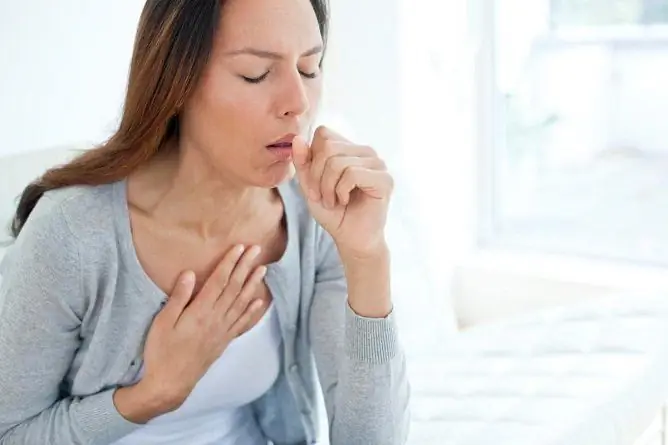- Author Rachel Wainwright [email protected].
- Public 2023-12-15 07:39.
- Last modified 2025-11-02 20:14.
Treatment of pneumonia with folk remedies: how to treat pneumonia
The content of the article:
- Etiology of pneumonia
- Symptoms of pneumonia
- Diagnostics
-
Pneumonia treatment
How to treat pneumonia with folk remedies
- Video
Treatment of pneumonia with folk remedies should be carried out in addition to the main therapy or after the end of the course of antibiotics. Inflammation of the lungs is one of the most common diseases and can occur at any age in both adults and children. The disease has certain features of the course at different age periods. The pathology is based on acute inflammation of the lung tissue caused by microorganisms of various nature.

If you have symptoms of pneumonia, you should immediately consult a doctor
Currently, all over the world, pneumonia occupies the 4th-5th place in the structure of causes of death after cardiovascular pathology, cancer, cerebrovascular pathology and chronic obstructive pulmonary diseases, and among infectious diseases - the first place.
Therefore, you should not self-medicate; if symptoms of inflammation appear, it is recommended to immediately consult a doctor. In this case, folk remedies can be used only in the absence of contraindications, after consulting directly with the attending physician.
Etiology of pneumonia
The main etiological factor of the disease is the pathogenic agent. Pneumonia is divided into community-acquired and nosocomial pneumonia.

Most often, bacteria, in particular pneumococcus, lead to the development of pathology.
In the occurrence of community-acquired pneumonia, the leading role belongs to pneumococcus, Haemophilus influenzae and Staphylococcus aureus. Also, the cause may be atypical pathogens: mycoplasma, chlamydia, legionella.
The cause of nosocomial infection of lung tissue is conditionally pathogenic and gram-negative flora: Staphylococcus aureus, Klebsiella, Escherichia coli, Proteus, Legionella.
During epidemics of influenza, viral pneumonia occurs, to which bacterial and mycoplasma flora often joins. Mixed infection occurs in almost every second case.
Symptoms of pneumonia
The clinical picture of pneumonia is characterized by a varied combination of bronchopulmonary and extrapulmonary symptoms, the severity of which may vary depending on the characteristics of the pathogen and the state of the human body.
The patient complains of cough, shortness of breath, chest pain, discharge of mucopurulent or bloody sputum, general weakness, muscle pain. Determined by fever, chills, heart palpitations, confusion, changes in the frequency and depth of respiratory movements (18-20 movements per minute).
Diagnostics
To establish a diagnosis, clinical, laboratory and radiological signs are taken into account:
- fever;
- cough;
- sputum;
- leukocytosis;
- radiographically detectable infiltration.

A chest x-ray is taken to make a diagnosis
But the frequency of both overdiagnosis and underdiagnosis of pneumonia ranges from 15 to 50%, so it is very important to take into account that there may be individual characteristics of the course of the disease.
On examination, the doctor determines the dullness of the percussion sound, weakened vesicular or bronchial breathing, crepitus, pleural friction noise.
An important and mandatory step is the establishment of a presumptive diagnosis based on clinical and epidemiological data. This takes into account the etiological structure of modern pneumonia.
Of great importance for the diagnosis of pneumonia is Gram staining of sputum smear, which makes it possible to identify gram-positive and gram-negative pathogens, intracellular and extracellular localization of microorganisms.
Also shown is bacteriological examination of sputum with determination of sensitivity to antibiotics, quantitative calculation of the pathogen.
According to the indications, a study of the aspirate, a washout obtained during fibrobronchoscopy, blood culture, as well as the determination of antibodies to antigens of various pathogens in the blood serum is carried out.
Pneumonia treatment
For mild pneumonia, therapy can be done at home. With a moderate and severe course of the disease, as well as the presence of a burdened history, concomitant acute or chronic pathologies, the patient must be hospitalized in a hospital, where complex treatment will be under the supervision of doctors.

Hospitalization is indicated for patients with moderate and severe pneumonia
The therapy is based on the use of antibacterial drugs, which are selected depending on the form of pneumonia, the severity of the general condition of the patient.
Before using the antibiotic, an allergic history is compulsorily collected and an allergic test is performed. The presence of an allergy to the active substance or intolerance to the drug in the past is an absolute contraindication for the appointment of one or another antibiotic.
Due to the impossibility in most cases to determine the type of pathogen and even more so its sensitivity to antibiotics, the drugs of choice in the treatment of pneumonia are antibacterial agents of a wide spectrum of action:
- beta-lactam antibiotics (penicillins, cephalosporins);
- macrolides;
- fluoroquinolones;
- aminoglycosides.
Beta-lactam antibiotics enter sputum well, but are less concentrated in the lung parenchyma and bronchial mucosa. Many causative agents of respiratory diseases are located precisely in the lumen of the bronchi or mucous membrane, therefore, for successful treatment, large doses of beta-lactam drugs (Amoxiclav, Ceftriaxone) are required.
Macrolides provide a high concentration of antibacterial substance in the tissues and fluids of the respiratory tract. And due to the ability to diffuse, there is a better accumulation of the antibiotic in the lung tissues - the concentration of the active substance in them is much higher than in the plasma.
One of the most popular drugs from the group of macrolides-azalides is Azithromycin. It needs to be taken in a course of 5 days. After a single injection of the drug, its concentration remains at a high level for 48-96 hours. The agent penetrates well into the lining epithelium.
Of particular importance is the concentration that antibacterial agents reach in alveolar macrophages. For comparison, highly ionized beta-lactam drugs practically do not penetrate intracellularly, and macrolides accumulate in macrophages at a concentration that is many times higher than their concentration in the extracellular space, making these drugs excellent for combating intracellular pathogens.
Fluoroquinolones (Levofloxacin, Sparfloxacin) are characterized by the ability to accumulate in the bronchial mucosa at about the same concentration as in the blood plasma. Their concentration in the epithelial fluid is very high. Thus, the effectiveness of drugs in this group is determined by the duration of action and concentration. Fluoroquinolones are contraindicated in children and pregnant women.
When taking drugs of the aminoglycoside group (Vancomycin, Gentamicin), the same tissue and plasma concentration is created. Antibiotics act on most respiratory pathogens by concentrating in the fluid covering the epithelium of the lower respiratory tract.
When conducting antibiotic therapy, in some cases it seems rational to use a combination of drugs, which leads to an increase in the antimicrobial effect and helps to fight a wider range of potential pathogens.
The approach to treating patients with pneumonia may vary depending on age, general condition, and severity of the condition. Upon receipt of the results of bacteriological examination of sputum, the antibacterial group or drugs can be replaced if the pathogen is insensitive to the selected drugs.
When treating at home, in order to purchase antibiotics, you need a prescription from a doctor, in addition to the name of the drug, it contains the dosage and method of administration.
In addition to antibacterial therapy, symptomatic treatment is carried out, aimed at eliminating the manifestations of the inflammatory process. Medications containing paracetamol are used to reduce body temperature in case of fever.
It is important to prescribe expectorant drugs that thin phlegm and contribute to its better excretion: Herbion, Codelac, ACC, Bromhexin.
How to treat pneumonia with folk remedies
In addition to the main therapy in the treatment of pneumonia, various traditional medicines are used: herbal decoctions, rosehip infusion, aloe juice, compresses.
To strengthen the immune system, it is recommended to consume 1 spoonful of honey 1 time a day or garlic at night before bed. You can also dilute honey in 50 ml of warm water, add a slice of lemon and drink in the morning on an empty stomach.

During the treatment period, you can take tea from raspberry leaves
A patient with pneumonia is advised to drink plenty of fluids to replenish lost fluid due to fever and inflammation. For this, teas with currant and raspberry leaves or a mixture of various herbs, the components of which can be coltsfoot, wild rosemary, linden, and plantain, help well. The herbs must first be poured with boiling water and insisted. Several glasses of tea a day are recommended. Along with this, to replenish the water balance, you can drink mineral water.
Among the herbal remedies that stimulate expectoration, rhizomes of licorice and marshmallow, thermopsis herb, oregano, thyme can be used. The charges, together with the secretomotor action, have an anti-inflammatory, disinfectant and sedative effect.
Adults and children in the absence of impaired renal function can take decoctions / infusions of roots and rhizomes of elecampane as an expectorant, diuretic, anti-inflammatory and tonic. To do this, 1 teaspoon of crushed raw materials is poured with one glass of boiling water and insisted in a thermos for 4 hours. Take before meals 3 times a day, 1 teaspoon.

It is recommended to use Icelandic moss in order to facilitate expectoration and weaken coughing attacks.
After the end of the course of the main therapy, a two-week reception of Icelandic cetraria is recommended. 1 tablespoon of raw materials is added to 200 ml of milk and boiled over very low heat, taken overnight. To relieve expectoration and ease coughing fits in the morning, you can drink tea from a mixture of Icelandic moss and coltsfoot in equal parts.
For daily collection, marshmallow, lungwort, mint, chamomile, anise are used. Plants should be well chopped and mixed thoroughly, trying to represent each plant in the mixture as evenly as possible. To prepare the infusion, 200 ml of boiling water is poured over 1 tablespoon of the collection in a thermos and insisted for 2-3 hours. Take half an hour before meals, 50 ml 4 times a day for a course of 7-10 days for complete restoration and purification of the bronchial epithelium.

Rosehip tea is indicated during the recovery period after illness.
With weakness and malaise during the recovery period, it is recommended to take a tincture of Rhodiola rosea: half an hour before meals, 10-30 drops 3 times a day for a course of 2-3 weeks. After 14 days, the reception can be repeated if necessary. Vitamin teas such as rose hips can also be used.
It should be remembered that it is impossible to cure pneumonia with folk remedies. Non-traditional therapies should be used in consultation with your doctor in addition to antibiotics or antiviral drugs.
Video
We offer for viewing a video on the topic of the article.

Alina Ervasova Obstetrician-gynecologist, consultant About the author
Education: First Moscow State Medical University. THEM. Sechenov.
Work experience: 4 years of work in private practice.
Found a mistake in the text? Select it and press Ctrl + Enter.






